18 Most Sustainable Canadian Clothing Brands: The Conscious Consumer’s Guide
Impactful Ninja is reader-supported. When you buy through links on our site, we may earn an affiliate commission.
Learn more
Learn more
.
Hey fellow impactful ninja ? You may have noticed that Impactful Ninja is all about providing helpful information to make a positive impact on the world and society. And that we love to link back to where we found all the information for each of our posts. Most of these links are informational-based for you to check out their primary sources with one click. But some of these links are so-called "affiliate links" to products that we recommend. First and foremost, because we believe that they add value to you. For example, when we wrote a post about the environmental impact of long showers, we came across an EPA recommendation to use WaterSense showerheads. So we linked to where you can find them. Or, for many of our posts, we also link to our favorite books on that topic so that you can get a much more holistic overview than one single blog post could provide. And when there is an affiliate program for these products, we sign up for it. For example, as Amazon Associates, we earn from qualifying purchases. First, and most importantly, we still only recommend products that we believe add value for you. When you buy something through one of our affiliate links, we may earn a small commission - but at no additional costs to you. And when you buy something through a link that is not an affiliate link, we won’t receive any commission but we’ll still be happy to have helped you. When we find products that we believe add value to you and the seller has an affiliate program, we sign up for it. When you buy something through one of our affiliate links, we may earn a small commission (at no extra costs to you). And at this point in time, all money is reinvested in sharing the most helpful content with you. This includes all operating costs for running this site and the content creation itself. You may have noticed by the way Impactful Ninja is operated that money is not the driving factor behind it. It is a passion project of mine and I love to share helpful information with you to make a positive impact on the world and society. However, it's a project in that I invest a lot of time and also quite some money. Eventually, my dream is to one day turn this passion project into my full-time job and provide even more helpful information. But that's still a long time to go. Stay impactful,Affiliate Disclosure
Why do we add these product links?
What do these affiliate links mean for you?
What do these affiliate links mean for us?
What does this mean for me personally?
![]()
Amid growing concerns about the textile industry’s environmental impact, there is pressure to find greener clothes for your wardrobe. And as modern supply chains for clothing tend to spread out all over the world, there is an argument to be made for lowering the impact of buying clothes by sticking with brands closer to home. So, we had to ask: Which are the most sustainable Canadian clothing brands?
The most sustainable Canadian clothing brands are Tentree, The Good Tee, and hernest project, which source low-impact materials and offset their carbon footprint. In addition, BEDI and Encircled minimize textile waste while adhering to ethical manufacturing.
Whether you are searching for a winter jacket or a T-shirt made in Canada to add to your wardrobe without negatively impacting the soil, the water, the animals, and other people, there is a brand for you. So, let’s keep reading to learn more about the most sustainable Canadian clothing brands and how they ensure sustainable, ethical practices.
Here’s How Sustainable Canadian Clothing Brands Generally Are
The geographical journey of garments often plays a big role in their sustainability because it affects many social and ecological aspects in a product’s life-cycle, from the treatment of textile workers to the use of chemicals.
“Sustainable: The ability to be maintained at a certain rate or level | Avoidance of the depletion of natural resources in order to maintain an ecological balance”
Oxford Dictionary
To understand the sustainability of Canadian clothing, we’ve assessed the life-cycle and each stage’s sustainability. This life-cycle assessment (LCA) is a method to evaluate the environmental impacts of products and materials. Here’s a quick summary of our LCA of Canadian clothing!
Here’s How We Selected the Most Sustainable Canadian Clothing Brands
The brands on this list were chosen based on their commitment and actions to promote sustainable practices while reducing the environmental impacts of the textile industry.
They are transparent about their materials, processes, and workforce management within their supply chain.
Some brands focus their efforts on reducing waste and optimizing natural resources while others strive to reduce the carbon footprint of their clothes.
All of these brands share the commitment to reshape the textile industry toward a more sustainable and Earth-friendly sector.
These Are the 18 Most Sustainable Canadian Clothing Brands
Most Sustainable Canadian Clothing Brands
Overall, these Canadian clothing brands are sustainable. Yet, they take various approaches to reduce environmental impacts and uphold ethical standards. Let’s dive into each brand and find out more.
Tentree: A Lifestyle Clothing Brand That Plants Trees for Every Item Purchased

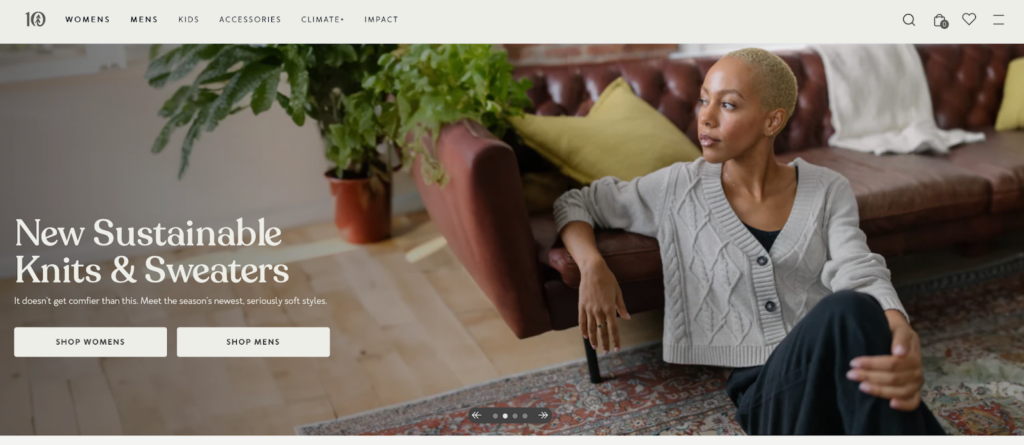
“ We believe the future of business is restorative.”
Tentree
🌎
How do they ensure their sustainability?
Tentree ensures sustainability by planting trees, promoting circularity, opting for low-impact fabrics, and attaining responsible packaging. Since their inception, they have planted more than 100,000,000 trees, which helps regenerate ecosystems, capture carbon, and provide forestry jobs in communities around the world. Together with textile recycler SuperCircle and resale guru Treet, Tentree has created an integrated solution to resell or recycle pre-loved Tentree clothing items, keeping them in circulation and out of landfills. Tentree also uses eco-friendly fabrics and blends, including organic cotton, hemp, recycled polyester, and TENCEL™. For example, the InMotion Tank is made with recycled polyester (REPREVE®) and is ideal for hitting the gym. Regarding packaging, they have replaced all single-use plastics with FSC-certified and 100% recycled paper. Finally, they have B Corporation and Climate Neutral certifications.
🌐
How do they ensure their ethics?
Tentree enforces fair labor practices by collaborating only with manufacturers and suppliers that guarantee a safe and respectful environment for their employees. They also regularly audit their partner facilities to ensure compliance with their Code of Conduct and international labor standards. Part of their supply chains is certified by organizations that protect workers, such as Fair Wear Foundation, Global Organic Textile Standard, Sedex Members Ethical Trade Audit, and Worldwide Responsible Accredited Production – WRAP. Additionally, Tentree commits to protecting forests through their paper, packaging, and fabric choices.
🤝
Are they part of any giving-back programs?
Giving back is a cornerstone of Tentree’s mission. Tentree plants 10 trees worldwide for every item purchased, contributing to reforestation and combating climate change. In 2022 alone, their customers helped plant over 22 million trees across nine countries, restoring over 2,000 hectares of terrestrial forests, over 1,000 hectares of coastal mangrove forests, and hundreds of hectares of marine land.
🛍️
What is their product range?
- Best for: kidswear, menswear, womenswear
- Product range: T-shirts, tank tops, shirts, sweaters, cardigans, dresses, pants, hoodies, dresses, shorts, skirts, joggers, jackets, coats, underwear
- Price range: $$
- Size range: XXS–XXL
The Good Tee: Responsibly-Made Fashion Essentials
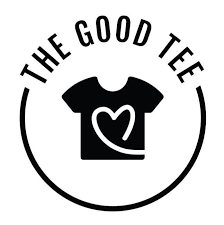
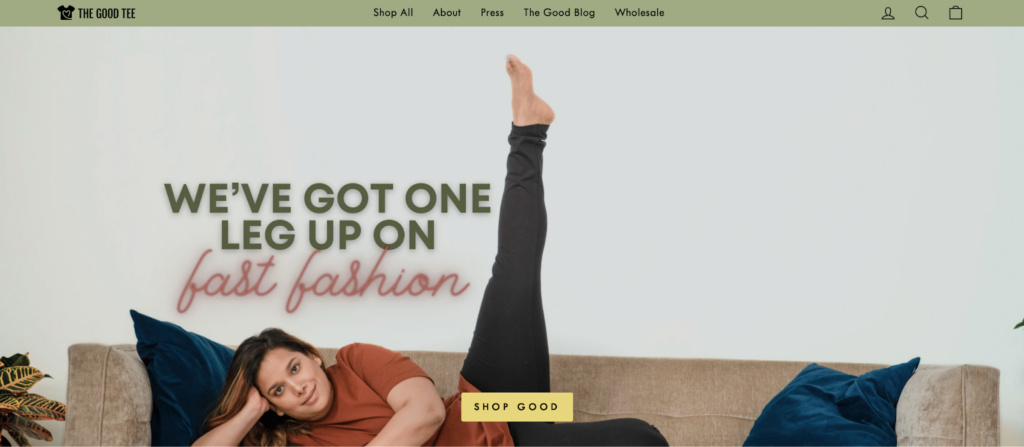
“Unlike the wear-today/replace tomorrow lifespan of a fast fashion garment, The Good Tee strives to enhance the lifespan of its products by emphasizing quality in all things – from fabric to thread and trims.”
The Good Tee
🌎
How do they ensure their sustainability?
The Good Tee ensures sustainability by sourcing eco-friendly materials and measuring their environmental impact to move toward net zero emissions. Firstly, they use a high proportion of GOTS-certified organic cotton to make their fabric, saving 71% water and 62% energy usage (compared with conventional cotton). Additionally, The Good Tee sources exclusively AZO-free and low-impact dyes from dye houses with a water effluent treatment plant that recycles and reuses water. The brand also considers the biodegradability and sustainability of their trims, including coconut and seashell buttons (instead of plastic buttons), biodegradable tags made of cotton or recycled paper, and YKK NATULON® zippers made from post-consumer chemically recycled polyester, which is perpetually recyclable. Regarding packaging, The Good Tee uses biodegradable bags and recycled boxes. Secondly, they have taken their first steps toward net zero by calculating their scope 1, 2, and 3 GHG emissions.
🌐
How do they ensure their ethics?
The Good Tee ensures their ethics by being fully transparent about their supply chain. They openly share their supply chain map, from farms to production to logistics. The brand exclusively sources Fairtrade cotton cultivated in India and manufactures in Fairtrade-certified factories, ensuring fair working conditions and payments for both farmers and textile workers while protecting ecosystems. They also audit their suppliers. Additionally, The Good Tee has a Code of Conduct that covers all of the ILO’s Fundamental Principles and Rights at Work.
🤝
Are they part of any giving-back programs?
The Good Tee advocates for the rights of farmers and textile workers by adhering to supply chain transparency and fair trade practices. Their manufacturing partner, Assisi Garments, invests in the community by supporting various social projects, including a nursing home and children’s orphanage in South India.
🛍️
What is their product range?
- Best for: womenswear, menswear, kidswear
- Product range: short-sleeve T-shirts, long-sleeve T-shirts, ¾-sleeve T-shirts, sweaters, dresses, tanks, bottoms,
- Price range: $$
- Size range: S–XL
hernest project: Sustainably Made Sleepwear and Loungewear

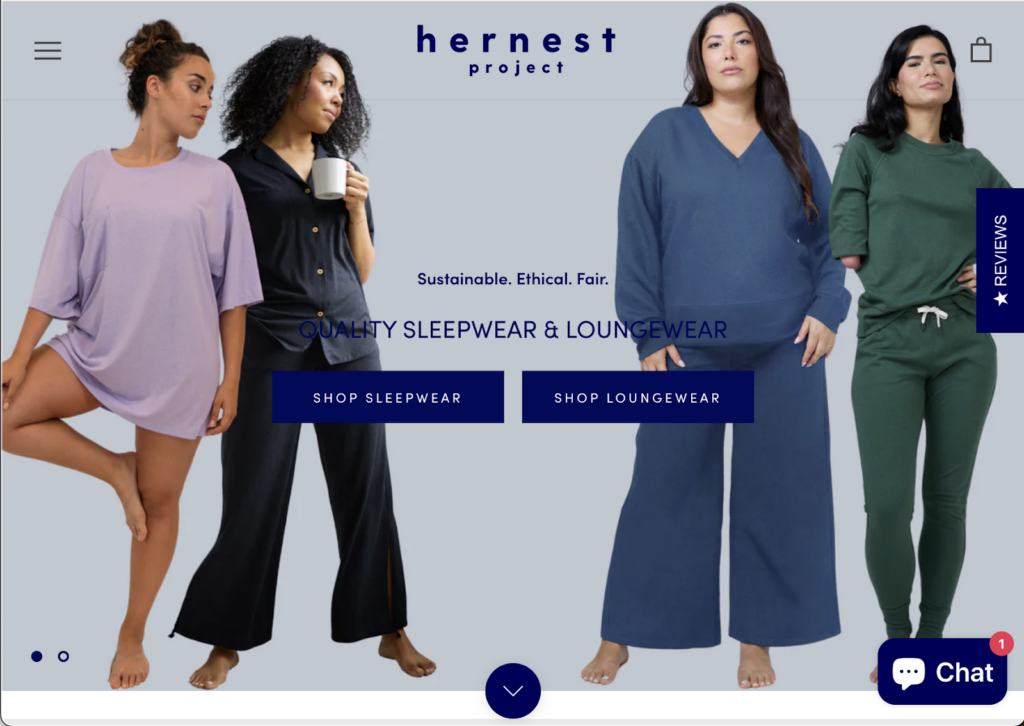
“We cause zero harm. This means that we do not contribute to the systemic increase in substances extracted from the earth’s crust, to the accumulation of compounds that do not break down in nature, to degradation of natural systems and to the barriers that prevent people from meeting their needs.”
hernest project
🌎
How do they ensure their sustainability?
hernest project ensures sustainability by sourcing a high proportion of low-impact materials, reducing textile waste, and offsetting carbon emissions to reach carbon neutrality. Firstly, all their fabrics bear OEKO-TEX® STANDARD 100 certification and feature Bluesign®-approved dyes. Low-impact plant-derived and plant-based TENCELTM, recycled cotton, and organic cotton account for the highest proportions of their collection (37%, 21%, and 21%, respectively). Additionally, they lessen the burden on earth resources by using recycled fabrics, including recycled lyocell, recycled linen, and recycled spandex. Regarding packaging, hernest project uses compostable garment protectors, brief liners, eCom mailers, and organic cotton brand tags. Secondly, they cut down textile waste by operating on limited runs, employing cutting-edge and computer-aided programs to minimize offcuts in the production process, and having their production supplier recycle all offcuts. Excess fabric is made into scrunchies. Additionally, hernest project designs are based on slow-fashion principles of timelessness and versatility. They also strive toward circularity by partnering with Treet to facilitate the sale of pre-loved garments. Last but not least, they invest in offset projects such as renewable energy, forest conservation, and energy efficiency to ensure that every item ordered and sold on their site is carbon neutral.
🌐
How do they ensure their ethics?
hernest project ensures their ethics by binding their supplier with a Code of Conduct, covering all of the ILO’s Fundamental Principles and Rights at Work. They also have traceability for their Tier 1 and Tier 2 suppliers.
🤝
Are they part of any giving-back programs?
hernest project works with women’s shelters to donate returns and samples of clothes.
🛍️
What is their product range?
- Best for: womenswear
- Product range: tops, cardigans, crewnecks, joggers, pants, shorts, tanks, T-shirts, sleepwear, loungewear, plus-size
- Price range: $$
- Size range: XXS–3XL
BEDI: Sleek Winter Coats and Durable Bags From Recycled Materials


“Exceptionally sustainable materials and Canadian craftsmanship have resulted in a collection of utilitarian designs with impeccable detailing.”
BEDI
🌎
How do they ensure their sustainability?
BEDI ensures their sustainability by sourcing low-impact materials, minimizing waste, and reducing carbon emissions. Firstly, BEDI uses a high proportion of recycled and upcycled materials repurposed from various waste streams. These include ECONYL®, a 100% regenerated nylon fiber made from discarded fishing nets, premium leather salvaged from the furniture and aviation industries in Italy, car seat belts from scrap yards, deadstock weather-resistant twill taken from leftover outdoor furniture fabric, and recycled metal. Specifically, their OEKO-TEX®-certified ECONYL® materials, used in all their outerwear and approximately 48% of their bags, are highly water resistant, reducing the likelihood of microfiber releases. Additionally, BEDI opts for low-impact materials when it comes to virgin fabrics. Specifically, they use sustainably grown cotton, RWS-certified merino wool, and vegan leather made from cactus (Desserto®). Secondly, the brand takes many approaches beyond salvaging and upcycling existing materials to minimize waste. They employ technology to determine the optimal layouts to keep excess fabric as small as possible. In particular, small fabric scraps from cutting are used to make bag sections and keychains. Furthermore, they make everything in small batches, enabling real-time adjustments to minimize waste. And their efforts to reduce waste don’t stop when their products leave the store. BEDI offers a lifetime guarantee on all outerwear and bags with which they fix broken items for free, keeping them in circulation longer. Their “Second Life” program enables customers to return any BEDI to be refurbished and sold. Lastly, BEDI keeps their carbon emissions via manufacturing locally in Montreal, where 99% of electricity comes from renewable sources, making products by hand, transporting materials by boats, and shipping out orders with carbon-neutral shipping partners.
🌐
How do they ensure their ethics?
BEDI traces most of their suppliers and holds the final production stage in Canada, a low-risk country for labor abuse. They state that all BEDI employees and contractors are paid a living wage. They also share the makers of their products on their website.
🤝
Are they part of any giving-back programs?
BEDI is not known to be part of any giving-back programs.
🛍️
What is their product range?
- Best for: womenswear, menswear
- Product range: outerwear, knitwear, accessories
- Price range: $$$
- Size range: XS–3XL
Encircled: Minimalist Clothing Essentials Made Without Compromising Style, Comfort, or the Planet

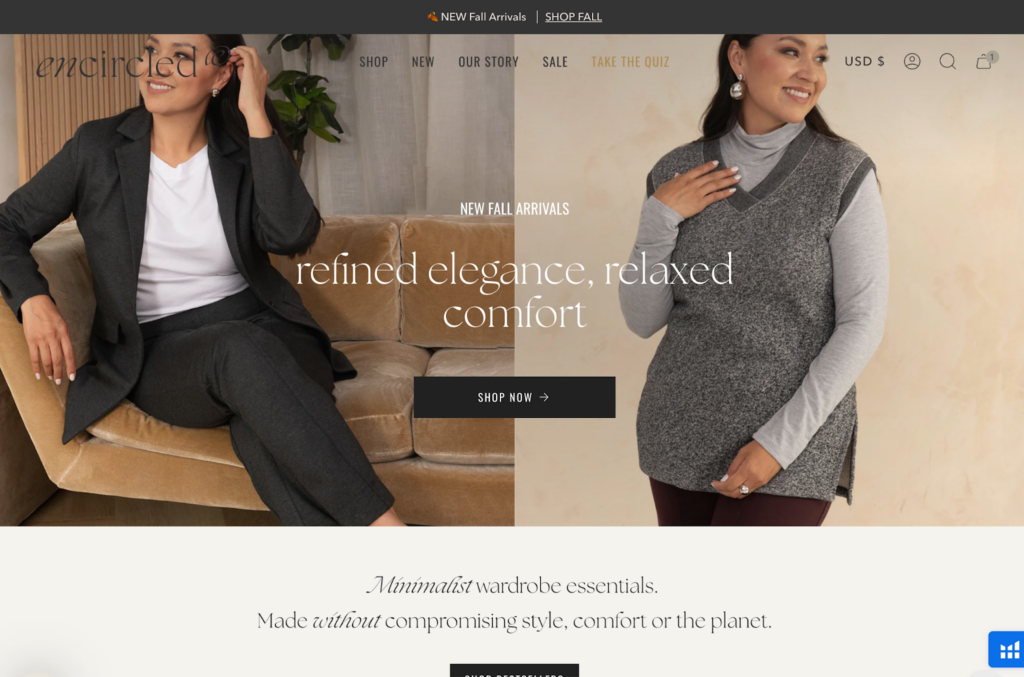
“Ethically made from the finest, most soft and flattering eco-friendly fabrics, our collection is designed with intention, flexibility and exceptional fit at its heart.”
Kristi Soomer, Founder of Encircled
🌎
How do they ensure their sustainability?
Encircled prioritizes sustainability through minimizing waste and maximizing options. On top of that, they are vigilant about closing gaps in the supply chains and the life of each piece of clothing. Their sewing studios upcycle all scrap fabrics into accessories, putting them up for quarterly sales. On their Encircled Renewed Threads platform, you can find pre-loved items for sale. It is also possible to buy, sell, or trade Encircled clothes on their Facebook community page. Other environmental incentives include using green energy to power their office and host their website, FSC-certified and eco-friendly paper and cleaning products, and 100% recyclable packaging. Encircled also manufactures their products locally and spends at least 50% of their non-labor expenses at local independent suppliers to reduce their carbon footprint. Lastly, they prioritize natural fabrics, such as organic cotton and linen, and low-impact, plant-based semi-natural fabrics, such as TENCEL™ Lyocell, TENCEL™ Modal, and LENZING™ ECOVERO™.
🌐
How do they ensure their ethics?
Encircled puts ethics at the core of their operations. Their final stage of production is undertaken in Canada, a low-risk country for labor abuse. They uphold each factory in their supply chain to an Ethical Code of Conduct checklist, exceeding what the law requires. Encircled also visits their international suppliers regularly. Lastly, they advocate continuously for diversity and inclusion.
🤝
Are they part of any giving-back programs?
Encircled is not known to be part of any giving-back programs.
🛍️
What is their product range?
- Best for: womenswear
- Product range: skirts, dresses, pants, jackets, blazers, knitwear, tops, blouses, T-shirts, stockings, tights, jumpsuits, playsuits, accessories, plus-size
- Price range: $$$
- Size range: XS–XXL
FRANC: Timeless Basics for a Conscious Wardrobe

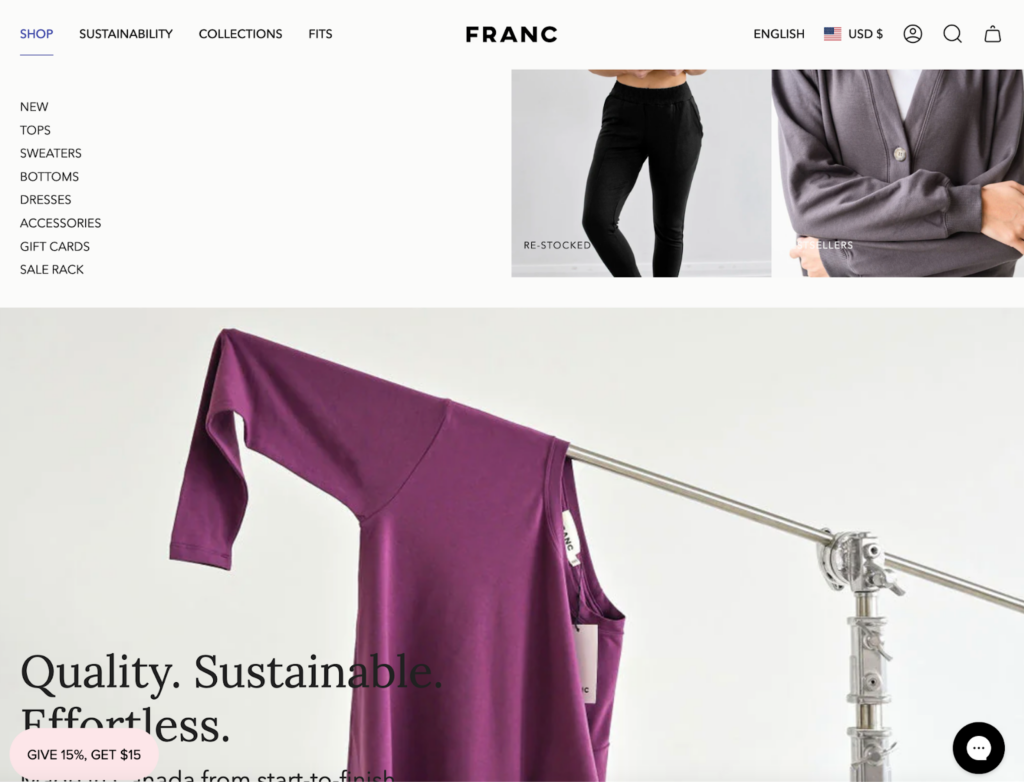
“We are a small business that is always striving to improve the lives of the people and planet around us, in whatever way we possibly can.”
FRANC
🌎
How do they ensure their sustainability?
FRANC ensures sustainability by using eco-friendly materials and lowering their carbon footprint. Firstly, they source yarns of low-impact fibers, mainly TENCELTM Lyocell and GOTS-certified organic cotton, to be knitted and then colored with Bluesign®-certificated dyes, non-toxic, low-impact, environmentally-friendly dyes locally in Toronto. Additionally, FRANC doesn’t use any plastics. Their shipping bags are made from kraft paper and are 100% compostable and recyclable. All their marketing materials (which includes hang tags) are printed on 100% recycled or FSC-certified paper. Secondly, FRANC reduces their carbon footprint by offsetting the shipping emissions in projects driven by groundbreaking technologies that remove carbon for a minimum of 1,000 years. For example, they support Running Tide, which drops carbon-soaked kelp to the ocean floor. The brand further reduces their climate impact by manufacturing locally. Specifically, their manufacturing partners are about 20km (12.5 miles) from their HQ.
🌐
How do they ensure their ethics?
FRANC traces most of their supply chain and visits their suppliers regularly. Their final stage of production happens in Canada, a low-risk region for labor abuse.
🤝
Are they part of any giving-back programs?
FRANC donates all their seconds, samples, and overstock to the YWCA, a group of women’s shelters in Toronto.
🛍️
What is their product range?
- Best for: womenswear
- Product range: tops, sweaters, bottoms, dresses, accessories
- Price range: $$
- Size range: XXS–4XL
Wuxly: Next-Gen Jackets Made With Innovative and Plant-Based Textile


“With only 1% of textiles being recycled worldwide, we’re working towards circularity, through up-cycling waste into high-performing outerwear and re-circulating older outwear to those in need with our Trade Up Program.”
Wuxly
🌎
How do they ensure their sustainability?
Wuxly ensures their sustainability by sourcing eco-friendly materials and striving for circularity. Firstly, they opt for high-performance materials that are recycled or bio-based. Their fabrics include bio-based performance fiber Sorona®, recycled nylon, and recycled polyester. Additionally, Wuxly sources exclusively from suppliers approved by Bluesign and OEKO-TEX®. This means their materials are subject to the highest environmental standards and contain no harmful chemicals. Secondly, the brand strives for circularity by keeping materials in circulation longer and limiting textile waste from being sent to landfills. Specifically, their warranty and repair programs enable a longer lifespan for each garment while their Trade Up program cycles old outerwear back into the community to those in need. Wuxly also limits excess inventory thanks to a thoughtful production policy involving strategic forecasting and limited runs of styles. On top of that, they partner with other brands to create something new from their textile waste, such as the Cozy Clutch made from Wuxly’s 100% recycled polyester deadstock in partnership with ai.
🌐
How do they ensure their ethics?
Wuxly traces most of their suppliers and holds their final production stage in Canada, a low-risk country for labor abuse. Regarding animal welfare, their entire range is animal-free, avoiding the common cruel treatment subjected to animals in the fashion supply chain.
🤝
Are they part of any giving-back programs?
Wuxly funds a plastic collection across Ocean Co.‘s partner collection network, supporting projects that create the most impact for communities across the globe.
🛍️
What is their product range?
- Best for: menswear, womenswear, kidswear
- Product range: parkas, puffers, vests, bombers, raincoats, fleece, loungewear, accessories
- Price range: $$$
- Size range: S–XL
Kotn: Quality Essential Designed in Canada and Made Ethically in Egypt

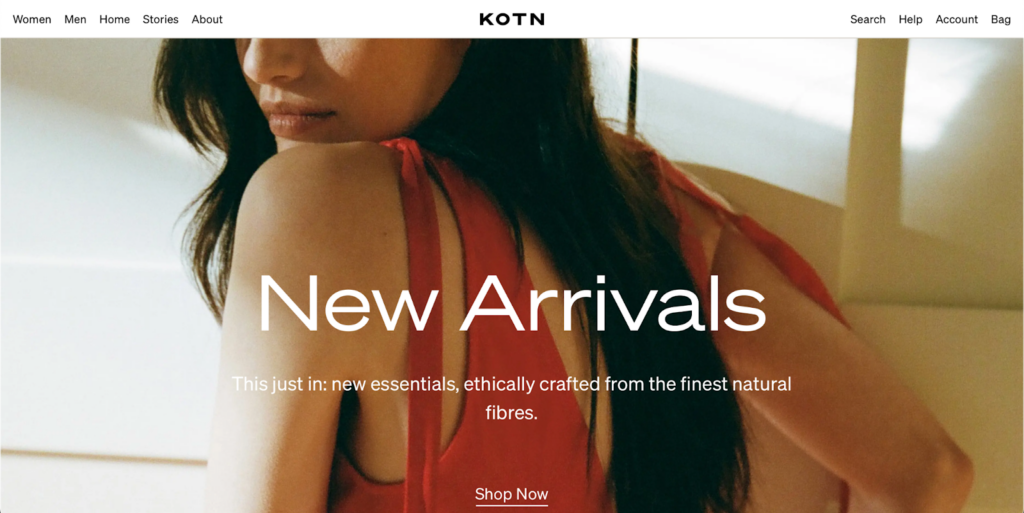
“A world of timeless designs that honour the people who make them and the places they’re made.”
Kotn
🌎
How do they ensure their sustainability?
Kotn ensures their sustainability by sourcing some eco-friendly materials and minimizing textile waste. Firstly, they focus on natural fibers, which can biodegrade at the end of their life-cycle, including cotton, linen, and merino wool. Their cotton stock, in particular, comprises GOTS-certified organic cotton, Better Cotton Initiative cotton, and ECOTEC recycled cotton. Kotn also sources TENCELTM Lyocel, a biodegradable regenerated fibers made in a closed-loop manufacturing system. The brand is also committed to using environmentally safe materials to transport all their pieces from their first to their final step. These include a recycled and recyclable cardboard mailer and a complimentary sustainably crafted tote. Secondly, the brand reduces textile waste by utilizing low-waste cutting methods and upcycling leftover materials.
🌐
How do they ensure their ethics?
Kotn ensures their ethics by working directly with responsibly-run facilities to ensure fair wages and treatment throughout their supply chain, better prices for their customers, and 100% traceability from farm to hanger.
🤝
Are they part of any giving-back programs?
Kotn donates a portion of their annual proceeds to fund and build primary schools in the Nile Delta and Faiyum, Egypt, investing in their farming communities’ long-term economic growth. So far, they have funded 21 schools.
🛍️
What is their product range?
- Best for: womenswear, menswear
- Product range: T-shirts, tanks, tops, bottoms, dresses, suits, socks, accessories knitwear
- Price range: $$
- Size range: XXS–XXL
Londre Bodywear: High-Quality Swimwear Made From Recycled Plastic Bottles

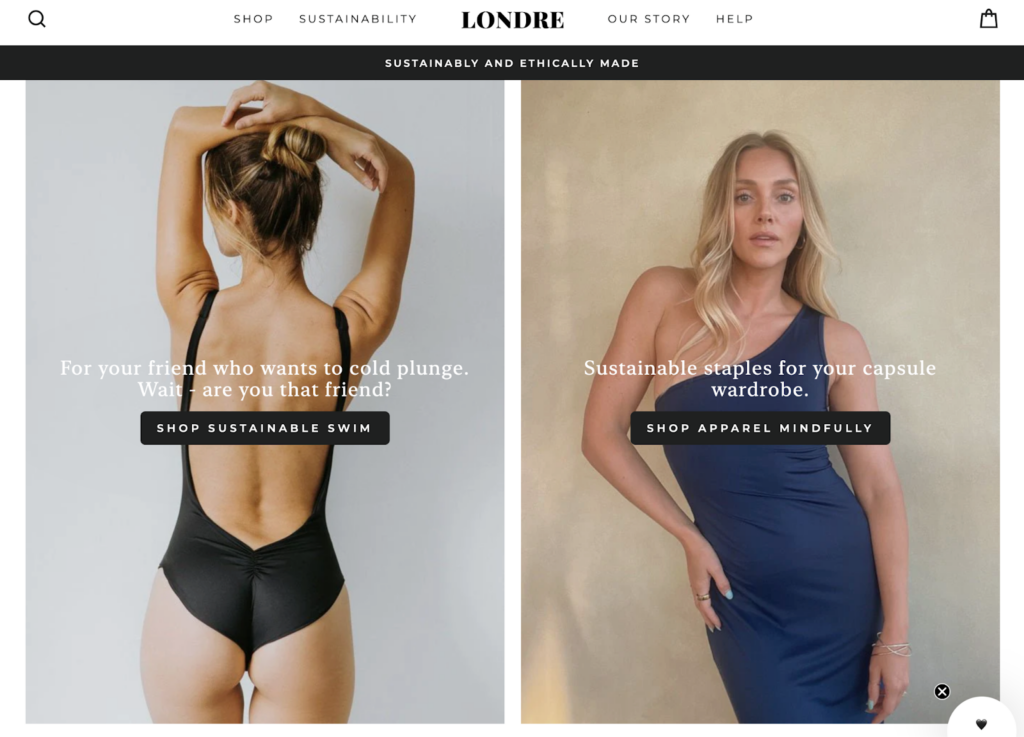
“So far, we’ve taken over 1 million plastic bottles from the beaches and streets to create our swimwear, with a minimum of 6 recycled plastic bottles in every swimsuit.”
Londre Bodywear
🌎
How do they ensure their sustainability?
Londre Bodywear promotes sustainability by reducing and minimizing waste. Specifically, they divert plastic bottle waste away from beaches and streets and into making fabrics for their swimwear. Their collection also comprises a high proportion of OEKO-TEX® STANDARD 100-certified recycled fabrics. Additionally, their packaging material is minimal, compostable, and recyclable. Further down the life-cycle in the manufacturing stage, they run small production batches to minimize waste. Also, their waste reduction effort doesn’t stop after the sale. Instead, if needed, Londre Bodywear offers compensation for repair in the first year after purchase. Lastly, they strive to close the loop by designing swimsuits that can be recycled into new materials at the end of their long life.
🌐
How do they ensure their ethics?
Londre Bodywear holds their final stage of production in Canada, a low-risk region for labor abuse. They state that they pay all sewers well above the living wage. Additionally, Londre Bodywear traces most of their supply chain and visits their suppliers regularly.
🤝
Are they part of any giving-back programs?
Londre Bodywear has donated tens of thousands of dollars to environmental and women’s health initiatives, including Amazon Watch and The Ocean CleanUp Project. They have also partnered with other organizations involved with coral reef rejuvenation.
🛍️
What is their product range?
- Best for: womenswear
- Product range: swimwear, dresses, jackets, skirts, tops, plus-size
- Price range: $$
- Size range: XS–4XL
TAMGA Designs: Luxurious, Lightweight, and Forest-Friendly Clothing
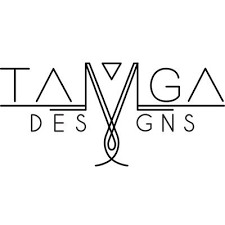
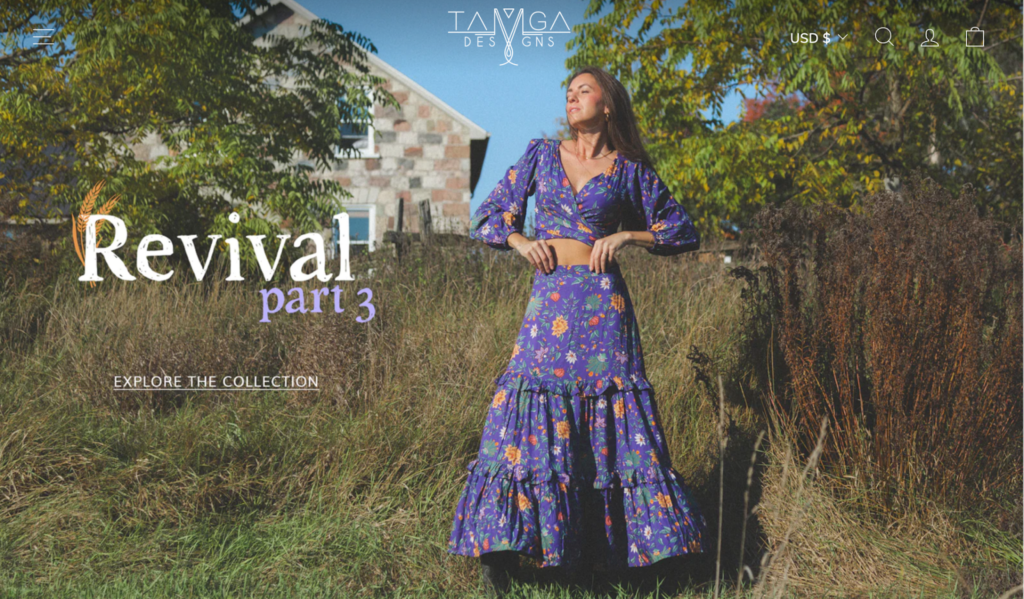
“We believe in a bright future for our planet, which is why we only use fabrics made from traceable and sustainable botanic fibers. ”
TAMGA Designs
🌎
How do they ensure their sustainability?
TAMGA Designs ensures sustainability by lowering their environmental impacts throughout the life-cycles of their clothes. In the material sourcing stage, they use only 100% biodegradable and recyclable fabrics, including low-impact, certified, traceable wood-based fabrics (lyocell, modal, viscose) from Lenzing and Canadian-original linen. To manufacture their colorful collection, TAMGA Designs opts for OEKO-TEX® STANDARD 100 certified dyes that use 70% less water than conventional synthetic dyes. Each finished product is packed in an unbleached GOTS-certified organic cotton tote bag that can be reused for traveling or home storage. Other packing elements are made with recycled, recyclable, or compostable materials. TAMGA Designs also uses the leftover fabric from previous collections to create their “Revival” collection. Lastly, they offset all carbon emissions to make their garments carbon-neutral. In 2022, through their partnership with SimpliZero, TAMGA Designs invested in Gold-Standard offsetting projects, including the Sirap Wind Farm in Indonesia, a Bundled Wind Power project in China, and a Clean Drinking Water project in Cambodia.
🌐
How do they ensure their ethics?
TAMGA Designs ensures their ethics by sharing every supplier that touches a TAMGA garment, from “field to fashion.” Their direct suppliers are upheld to a Code of Conduct that covers all of ILO’s Fundamental Principles and Rights at Work. They also visit most of their suppliers regularly.
🤝
Are they part of any giving-back programs?
Since their inception, TAMGA Designs has always given back a portion of their sales to causes they care about. Through their partnership with 1% for the Planet, they give 1% of the annual sales to the Sumatran Orangutan Society (S.O.S.). The fund is used to replant the rainforests in Sumatra, restoring one of the world’s most important biodiversity hotspots and bringing back the habitat for four critically endangered species, including orangutans, rhinos, elephants, and tigers. Additionally, they have a special T-shirt collection made with Lenzing’s viscose fabrics, Trees Please Tee, for which they contribute $10 per every sold item to S.O.S. In 2022, they celebrated Forest-Friendly-Friday and International Orangutan Day, donating 20% and 25% of all sales, respectively, to the Sumatran Orangutan Society.
🛍️
What is their product range?
- Best for: womenswear, kidswear
- Product range: skirts, shirts, dresses, pants, tops, blouses, shorts, jumpsuits, playsuits, T-shirts, kimonos, loungewear, accessories, plus-size
- Price range: $$$$
- Size range: XS–XXL
Terrera: Thoughtful, Timeless, and Comfortable Clothing Made Sustainably


“Our women-led team designs bi-annual collections of easy-to-wear clothing using fine quality natural fibres including bamboo, organic cotton, and Tencel.”
Terrera
🌎
How do they ensure their sustainability?
Terrera prioritizes sustainability by opting for eco-friendly natural fibers, low-impact manufacturing, and less carbon-intensive ocean transportation. They use certified organic bamboo and/or organic cotton in their fabrics. All of their clothing and home products, from fabrics to buttons, are also free of harmful substances and have the OEKO-TEX® STANDARD 100 certification. Particularly, their viscose fabrics are made with bamboo grown without chemical fertilizers, herbicides, or pesticides in a ‘closed-loop’ process that recycles water and recaptures the chemicals. Additionally, Terrera uses non-toxic and hypoallergenic dyes certified by OEKO-TEX® Standard 100 to sustainably color their fabrics. Once the clothing pieces are finished at Terrera’s Chinese suppliers, they are transported to Canada by ocean cargo ships, which have a much lower ecological footprint than airplanes.
🌐
How do they ensure their ethics?
Terrera is a part of Fashion Revolution, a global movement uniting people and organizations to work together toward radically changing the way our clothes are sourced, produced, and consumed so that their clothing items are made in a safe, clean, and fair way. Their suppliers are based in China and are audited annually by a third party to ensure that they exceed national standards for health and safety, workplace conditions, and workers’ protection.
🤝
Are they part of any giving-back programs?
Every November, Terrera hosts their Save Big, Give Back event, where they commit to donating 10% of all online sales to a selected charity. For example, in 2023, they supported the Dress for Success Canada Foundation, an organization that honors the courage of women to overcome immense obstacles to keep moving forward. Other organizations and charities Terrara supports include YWCA, Sanctuary Toronto, Urban Promise, Amazon Rainforest Conservancy, and Toronto City Mission. During the COVID-19 pandemic, they donated thousands of medical masks and gowns to Markham Stouffville Hospital, St. Michael’s Hospital, St. Joseph’s Health Centre, and long-term care facilities in the Greater Toronto Area, as well as reusable fabric masks to local charitable organizations.
🛍️
What is their product range?
- Best for: womenswear, menswear
- Product range: tops, tunics, sweaters, cardigans, dresses, jumpsuits, leggings, bottoms, sleepwear, socks, underwear, accessories
- Size range: XS–XXL
Miik: Canadian-Made Clothing With a Conscience
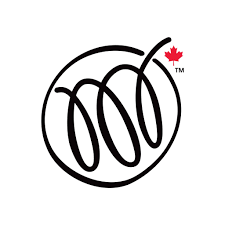
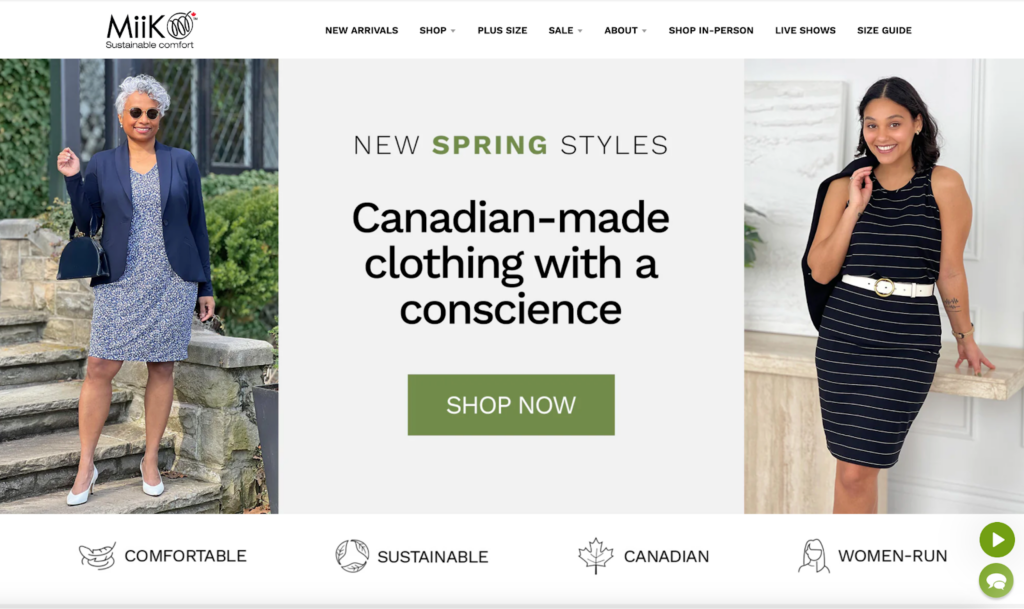
“Designed by women, for women, our collection of timeless classics and on-trend statement styles are designed to fit and flatter your body. ”
Miik
🌎
How do they ensure their sustainability?
Miik ensures sustainability by reducing their environmental impact in sourcing and manufacturing. Firstly, they custom-mill their fabrics from sustainably sourced fibers, primarily modal (Lenzing’s MicroModal) and bamboo rayon (viscose derived from bamboo with an OEKO-TEX® STANDARD 100 certification). The brand also blends GOTS-certified organic cotton and MicroModal fibers to create jacquard fabric. Further down the life-cycle in the manufacturing stage, they limit their production runs and make samples and small items from excess fabrics to reduce waste and recycle water in the supply chain to drive down water usage. Additionally, the brand mills the majority of their fabric (97%) and produces all their garments locally in Canada, reducing their climate impact. Altogether, Miik aims to create versatile, timeless, and long-lasting pieces, advocating for slow fashion’s principle of owning fewer garments and wearing each garment more.
🌐
How do they ensure their ethics?
Miik traces part of their supply chain. Their final production stage happens in Canada, ensuring a safe, fair, respectful working environment for every person involved in their production.
🤝
Are they part of any giving-back programs?
Miik considers giving back as an integral part of their ethos. They donate proceeds from every Miik order to various causes. For example, the Miik Foundation, founded in 2022 by Miik founder Donna and her husband Michael, donates $10,000 per year, funding three separate awards for Indigenous women, non-binary, and two-spirit individuals who are seeking financial aid toward their post-secondary education. They also periodically contribute a percentage of their sales to change-making organizations such as Sistering, Rainbow Railroad, Daily Bread Food Bank, and Help Us Help.
🛍️
What is their product range?
- Best for: womenswear
- Product range: dresses, tops, tunics, leggings, pants, skirts, blazers, jackets, cardigans, jumpsuits, accessories
- Price range: $$
- Size range: XS–XXL
Message Factory: Eco-Friendly Women’s Clothing Made Ethically

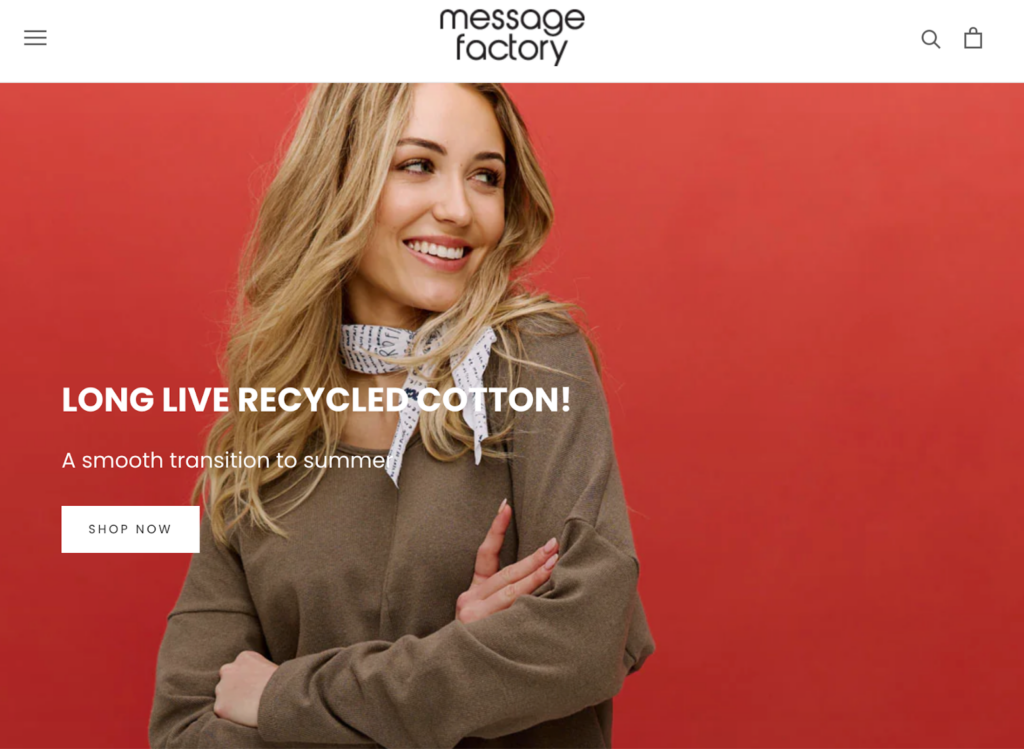
“We integrate sustainable practices into everything we do. From fabric to labels, our products are made of ecological materials. From presentation to delivery, we seek to minimize our impact on the planet. From choosing a supplier to hiring an employee, people are at the heart of our concerns.”
Message Factory
🌎
How do they ensure their sustainability?
Message Factory ensures their sustainability by using low-impact materials, minimizing textile waste, and reducing their climate impact. Firstly, they source a high proportion of eco-friendly fabrics. They prioritize organic and recycled fabrics, including GOTS-certified organic cotton, recycled cotton, recycled wool, recycled polyester, and OCS-certified hemp. Message Factory also used low-impact regenerated plant fibers, such as TENCELTM Lyocell and bamboo viscose. Garment components like buttons and labels are natural and biodegradable. Further down the life-cycle in the manufacturing stage, their fabrics are colored using water-based inks that comply with OEKO-TEX® STANDARD 100 and do not contain any harmful chemicals. Regarding packaging practices, they reduce the environmental impact with recycled and recyclable boxes and bags. In-store, they offer reusable and biodegradable bags. Secondly, Message Factory minimizes textile waste by producing in small batches. Lastly, they lower their carbon footprint by manufacturing locally in Quebec, less than 50 km (approx. 31 miles) from their shipping center. Besides, 75% of their fabrics are dyed and woven in the greater Montreal region, limiting transportation between subcontractors. Message Factory is also a B Corporation.
🌐
How do they ensure their ethics?
Message Factory traces most of their supply chain and visits all their manufacturers. Their final production stage happens in Canada, a low-risk country for labor abuse.
🤝
Are they part of any giving-back programs?
Message Factory gives back 1% of their sales to organizations that share their values. For example, they support La rue des Femmes, an organization that welcomes and cares for homeless women.
🛍️
What is their product range?
- Best for: womenswear
- Product range: tops, bottoms, tunics, dresses, underwear, accessories
- Price range: $$
- Size range: XS–XXL
Mariclaro: Bags and Accessories From Repurposed Materials
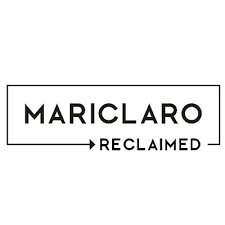
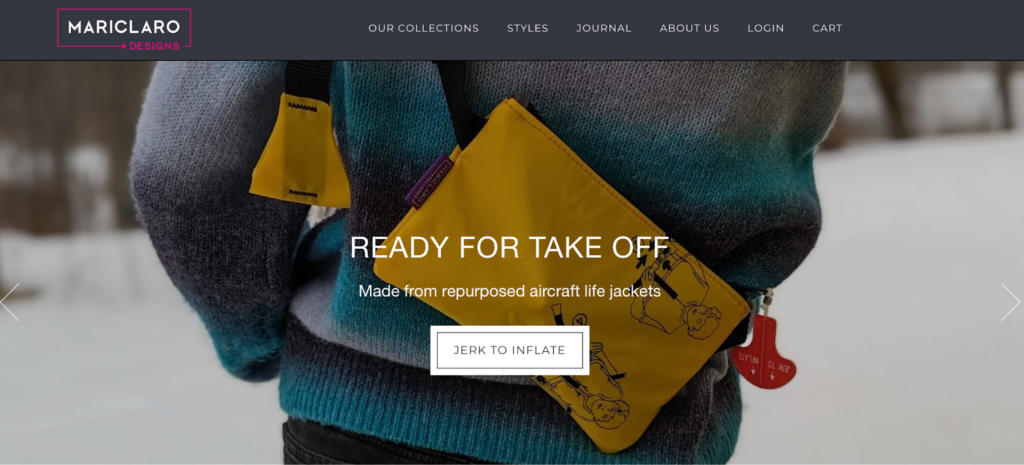
“We understand upcycling as a creative process of transforming discarded materials into contemporary and beautiful designs.”
Mariclaro
🌎
How do they ensure their sustainability?
Mariclaro ensures sustainability by repurposing waste materials to make bags and accessories. They specialize in working with automotive and aviation materials, transforming classic luxury car interiors and leather aircraft seats into unique bags, wallets, and passport cases. Further down the life-cycle in the manufacturing stage, they make their products by hand and locally in Canada to reduce their climate impact. Additionally, Mariclaro has a limited production run to minimize textile waste.
🌐
How do they ensure their ethics?
Mariclaro sources the waste materials that they use to make their products themselves and tries to trace back the origin of the material as best they can. Finally, their products are manufactured in-house.
🤝
Are they part of any giving-back programs?
Mariclaro is not known to be part of any giving-back programs.
🛍️
What is their product range?
- Best for: menswear, womenswear
- Product range: laptop bags, briefcases, handbags, backpacks, messenger bags, weekender bags, wallets, passport cases
- Price range: $$$
- Size range: one size
Good for Sunday: Canada-Made Clothing Focusing on Sustainability and Comfort
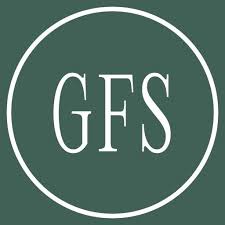
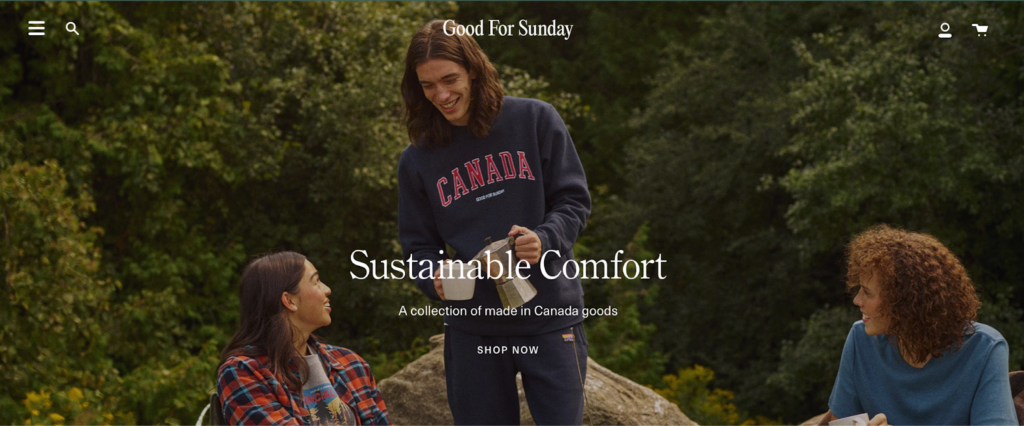
“At Good for Sunday, we think there’s a better way. We believe that when you do expand your wardrobe, it should be with pieces that are long lasting in both style and wear. Not trendy, but timeless. Crafted using high quality, ethical labour. Pieces that feature materials that have a lower impact on the planet, and use more sustainable cultivation practices.”
Good for Sunday
🌎
How do they ensure their sustainability?
Good for Sunday ensures their sustainability by lowering their environmental impact in sourcing and manufacturing. Firstly, they source low-impact textiles, including GOTS-certified organic cotton, linen, hemp, TENCELTM Lyocell, and bamboo. Good for Sunday is also environmentally conscious regarding their packaging. In particular, they have invested in compostable and recyclable materials for their mailers and product bags. Further down the life-cycle in the manufacturing stage, Good for Sunday employs various strategies to reduce their impact, including energy-saving knitting machines, screen printing using non-toxic water-based inks, textile waste reutilizing, and wastewater treatment for 100% reuse. Good for Sunday even tackles the impact of clothes returns with an innovative customer-to-customer return network, EcoDrop. Furthermore, Good for Sunday reduces their carbon footprint by producing locally and offsetting shipping emissions. Specifically, they mill, dye, cut, and sew every garment in Toronto, keeping their transport distances relatively low. They also neutralize the shipping emissions of every order by donating to reforestation projects. Their contributions currently fund the Jarí Para Forest Conservation Project in the Amazon Rainforest.
🌐
How do they ensure their ethics?
Good for Sunday ensures their ethics by being transparent about the cost breakdown of their products, of which the largest percentage comes from manufacturing locally in Canada. Additionally, they trace most of their supply chain and visit their suppliers regularly.
🤝
Are they part of any giving-back programs?
Good for Sunday supports important causes. For example, they donate $5 of every purchase of their “Save the Ocean” line to Sea Shepherd, an organization dedicated to defending, protecting, and conserving our oceans.
🛍️
What is their product range?
- Best for: womenswear, menswear, unisex
- Product range: tops, bottoms, accessories
- Price range: $$
- Size range: XS–2XL
Wildflo Studio: Organic Garments Made Responsibly in Small Batches


“At Wildflo Studio, we know you care about what you wear, just as much as what goes into what you wear. From the fabrics used, to the packaging your items arrive in, everything that went into bringing you these garments was done consciously. All of our pieces are made with organic fabrics, in small batches and by an ethical production process.”
Wildflo Studio
🌎
How do they ensure their sustainability?
Wildflo Studio ensures their sustainability by sourcing eco-friendly materials and minimizing textile waste. Firstly, they source low-impact textile and packaging materials. In particular, all of their garments are made with GOTS-certified organic cotton. Furthermore, they only use low-impact chemicals and dyes of at least 75% natural origin. Additionally, their packaging is 100% recyclable or compostable. Secondly, they manufacture in very small batches to minimize waste due to overproduction.
🌐
How do they ensure their ethics?
Wildflo Studio traces most of their suppliers and ensures payment of a living wage in their supply chain. Their manufacturing partner is an India-based factory with Fairtrade and GOTS certifications, focusing on organic garment manufacturing to support local organic cotton farmers. The facility and its practices are also routinely inspected and assessed by third-party organic certifiers.
🤝
Are they part of any giving-back programs?
Wildflo Studio is not known to be part of any giving-back programs.
🛍️
What is their product range?
- Best for: womenswear
- Product range: tops, bottoms, dresses, jumpsuits
- Price range: $$
- Size range: XS–XL
Meemoza: Feel-Good Clothes, Inspired by Nature
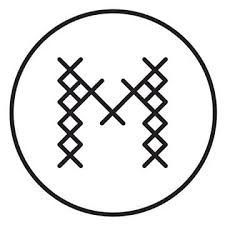
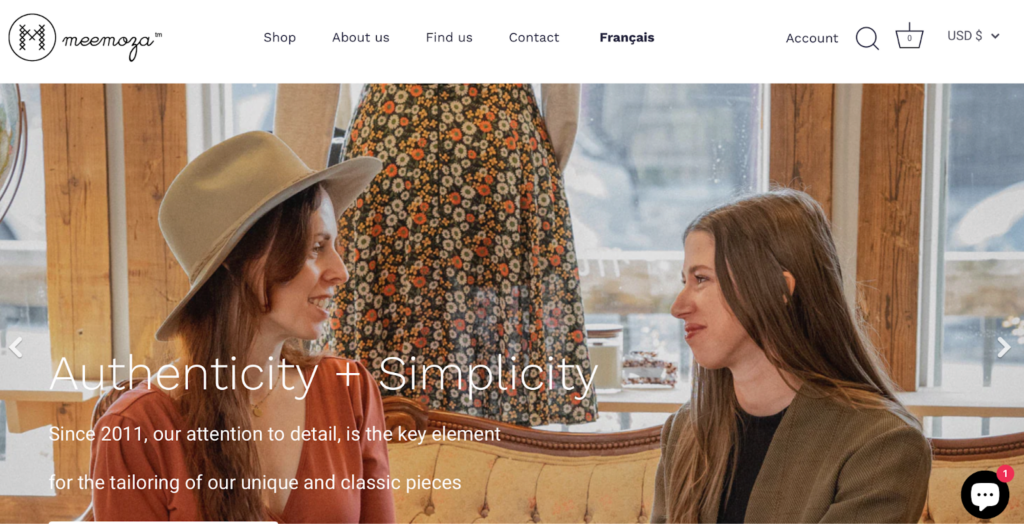
“Our ultimate goal is to tailor garments that allow you to feel good both inside and outside when wearing them.”
Meemoza
🌎
How do they ensure their sustainability?
Meemoza ensures their sustainability by sourcing low-impact materials and reducing textile waste. Firstly, they use a medium proportion of eco-friendly fabrics, including GOTS-certified organic cotton, lyocell, modal, and reclaimed textiles. Meemoza also opts to be responsible regarding packaging. They use recycled envelopes as mailers to send orders to individual consumers. For retailers, they opt for garment bags and shipping boxes. Secondly, the brand minimizes textile waste by giving any remnants or trimmings to independent artisans for their own production. The brand also limits their output to two collections per year, available in limited quantities to counter the negative impact of overproduction and fast fashion. Moreover, the brand offers an assortment of essential, timeless, practical pieces that can be worn season after season, promoting the less frequent consumption of quality clothing.
🌐
How do they ensure their ethics?
Meemoza partly traces their supply chain. The brand holds their final production stage in Canada, a low-risk country for labor abuse.
🤝
Are they part of any giving-back programs?
Meemoza is not known to be part of any giving-back programs.
🛍️
What is their product range?
- Best for: womenswear
- Product range: cardigans, shirts, skirts, shorts, pants, dresses, jumpsuits, lingerie accessories
- Price range: $$
- Size range: XS–XL
Frank and Oak: Thoughtfully Design Clothing That Is Made to Last


“We design durable products that blend timeless style with functional features that help lay the foundation for better living.”
Frank and Oak
🌎
How do they ensure their sustainability?
Frank and Oak ensures sustainability by adopting circularity and innovation as their design philosophy. Firstly, they source innovative and circular materials for both garments and packaging. The garments are made with biodegradable bio-based fabrics—hemp, kapok, non-mulesed merino wool, traceable yak wool, SeaCellTM, and ECOVEROTM—and recycled fabrics, including recycled cotton, recycled polyester, recycled nylon, recycled wool, and Seawool. In particular, the brand has a Circular DenimTM collection, which is designed with repurposed materials and with the consideration for easy recycling at the end-of-life. They collect worn-out materials, break them into fibers, and weave the recycled fibers with new fibers (organic cotton) to ensure their denim fabrics’ structural integrity and durability. Their denim garments are also hydro-less, meaning their finishing treatments, including Ozone wash, nano-bubble technology, and 3D laser distressing, use as little as 5% of water conventionally used in manufacturing denim. The production of their hydro-less denim garment also uses up to 79% less energy and up to 50% fewer chemicals. Furthermore, Frank and Oak partners with Cotton’s Blue Jeans Go Green™ program to collect worn-out denim jeans and transform them into something new. Regarding packaging, Frank and Oak uses recycled and recyclable kraft boxes and mailers. On top of that, their compostable poly bags are made with a biodegradable polymer that allows microorganisms in landfills to break them down fully. Secondly, they design their garments for easy recycling by avoiding mixing too many fiber types in one garment. In 2023, over 70% of their styles were made using only one or two types of fibers. Frank and Oak also strive to reduce their carbon emissions by partnering with GoBolt to have their orders delivered in a carbon-neutral fashion. Also in 2023, GoBolt delivered 15% of their orders using Electric Vehicles and another 25% carbon-neutral via carbon offsetting.
🌐
How do they ensure their ethics?
Frank and Oak ensures their ethics by upholding all their manufacturing partners to their Code of Conduct and having them audited by international organizations such as BSCI (Business Social Compliance Initiative), WRAP (Worldwide Responsible Accredited Production), SMETA, and SA8000. They also share some of their partners and factories on their website.
🤝
Are they part of any giving-back programs?
Through their partnership with Town Brewery, Frank and Oak donates to the David Suzuki Foundation, which aims to protect Canada’s oceans and marine life biodiversity. Additionally, in the three years from 2021 to 2023, they funded the replanting of close to 70,000 sqm of land under their yak yarn supplier’s Grassland Regeneration Program.
🛍️
What is their product range?
- Best for: womenswear, menswear
- Product range: denim, pants, dresses, coats, jackets, T-shirts, tops, blouses, shirts, sweaters, cardigans, blazers, overshirts, accessories
- Price range: $$
- Size range: XS–XXL
Why Is It Important to Buy Products Made of More Sustainable Fabrics
It is important to buy products made of more sustainable fabrics because a sustainable textile industry has a lower carbon footprint, helps save natural resources, and is better for forests, animals, and humans.
Buying Sustainable Fabrics Reduces Your Carbon Footprint
The production of clothing and footwear is estimated to contribute 10% of global greenhouse gas emissions—more than all international flights and shipping combined. If the fashion industry were a country, it would be the fourth largest emitter of carbon dioxide.
One way to reduce the carbon footprint of the clothes you buy is to opt for sustainable fabrics. Sustainable fabrics, which are often made with natural or recycled fibers, have relatively low carbon footprints compared to petroleum-based fabrics. For example, organic cotton made in the US has a carbon footprint of 2.35 kg CO2 (per ton of spun fiber)—a quarter of polyester’s carbon footprint.
Buying Sustainable Fabrics Reduces Demand for Natural Resources and Waste Management
The textile industry uses water and land to grow cotton and other fibers. It is estimated that 79 billion cubic meters of water were used for the sector worldwide in 2015. For example, producing a single cotton T-shirt requires as much water as one person drinks for 2.5 years (2,700 liters of fresh water).
Worse yet, the textile economy is vastly more linear than circular: the largest amount of resources used in clothes ended up in landfill (instead of being recycled to remake clothes). According to a report by the Ellen MacArthur Foundation,
- Less than 3% of materials used in the textile economy in 2015 came from recycled sources.
- In other words, more than 97% of resources used in making clothes are newly extracted.
When clothing items are disposed of within a short period of time—under a year in the case of half of the fast fashion clothes – the natural systems that provide raw materials for fabrics don’t have enough time to recover and regenerate, which could lead to ecological breakdown.
Sustainable fabrics are made with less water and emissions while lasting longer:
- Because they are durable, you don’t need to buy new clothes too often.
- Thus, you help reduce the pressure to extract more resources for making new items.
Similarly, making and consuming sustainable fabrics made with recycled materials reduces the demand for virgin materials while helping tackle waste management.
Buying Sustainable Fabrics Encourages Sustainable Management of Forests
Sustainable natural fiber fabrics are made with raw materials from forests and plantations that are sustainably managed, such as complying with FSC standards.
When you buy sustainable natural fiber fabrics, you discourage unsustainable forestry practices like illegal logging. You can help reduce deforestation, biodiversity loss, and the effects of climate change.
Buying Sustainable Fabrics Encourages Fairer Treatment of Animals
The fashion industry is rife with animal mistreatment when it comes to making animal-based fabrics like wool or silk. Every year, billions of animals suffer and die for clothing and accessories.
Buying sustainable vegan alternatives can help to reduce the pressure on raising more and more animals to meet the demand for animal-based fabrics while sacrificing their well-being and lives.
Suppose you have to buy fabrics made with, for example, wool or silk; make sure you only choose brands committed to cruelty-free products. In that case, you help advocate better treatments for animals raised within the textile industry.
Using Sustainable Fabrics Encourages Fairer Treatment of Textile Workers
Recent statistics from UNICEF estimated as many as 170 million child laborers worldwide, many of whom were engaged in some form of work in the textile industry. They don’t get paid minimum wages and often work long hours.
When you buy sustainable fabrics from brands transparent about the working conditions at their factories, you discourage the use of child labor and help promote better working conditions for textile workers.
How Can You Generally Buy More Sustainable Fabrics
The key to sustainably buying fabrics is to check on relevant environmental and original certifications.
For natural fabrics:
- Global Organic Textile Standard (GOTS): A globally recognized certification system that ensures a certain threshold of organic content has been met. It covers manufacturing, packaging, labeling, transportation, and distribution (but not what happens in the fields where crops are grown).
- USDA Certified Biobased Product: The USDA BioPreferred® Certification is a voluntary certification offered by the United States Department of Agriculture. The certification identifies products made from plants or other renewable materials.
- Ecolabel: Ecolabel is the official Canadian Union voluntary label recognized worldwide for certified products with a guaranteed, independently verified low environmental impact. The label requires high environmental standards throughout the entire life-cycle: from raw material extraction through production and distribution to disposal. It also encourages companies to develop innovative, durable, easy-to-repair, and recyclable products.
For natural fiber semi-natural/semi-synthetic fabrics:
- Forest Stewardship Council: An FSC certification ensures that the wood (or wood-like material) comes from responsibly managed forests that provide environmental, social, and economic benefits.
There are two types of FSC Certification:- FSC Forest Management Certification, with a focus on the origin of the wood—the forest.
- FSC Chain of Custody Certification, which focuses on the path from the forest to the customer’s home.
- Program for Endorsement of Forest Certification: PEFC’s approaches to sustainable forest management are in line with protecting the forests globally and locally and making the certificate work for everyone. Getting a PEFC certification is strict enough to ensure the sustainable management of a forest is socially just, ecologically sound, and economically viable but attainable not only by big but small forest owners.
For recycled fabrics:
- Recycled Claim Standard (RCS): The Textile Exchange RCS was originally developed as an international, voluntary standard that sets requirements for third-party certification of Recycled input and chain of custody.
- The Global Recycled Standard (GRS): The Global Recycled Standard (GRS) is an international, voluntary, full product standard that sets requirements for third-party certification of Recycled Content, chain of custody, social and environmental practices, and chemical restrictions. It can be used for any product with more than 20% recycled material.
For all types of fabrics:
- STeP by OEKO-TEX®: STeP by OEKO-TEX® is an independent certification system for brands, retailers, and manufacturers from the textile and leather industry. It communicates organizational environmental measures, including reducing carbon footprint and water usage.
- OEKO-TEX® Standard 100: OEKO-TEX® labels aim to ensure that products pose no risk to human health (i.e., containing banned chemicals).
Some certifications that are signaling brands’ efforts toward lowered environmental impacts and a circular economy are:
- B Corp Certification: The label B Corp is a certification reserved for for-profit companies. Certified holders are assessed on their social and environmental impacts.
- Cradle2Cradle certification: Cradle2Cradle provides a standardized approach to material circularity. It assesses whether products have been suitably designed and made with the circular economy in mind covering five critical categories: material health, material reuse, renewable energy and carbon management, water stewardship, and social fairness.
Final Thoughts
The geographical journey of garments often plays a big role in their sustainability because it affects many social and ecological aspects of a product’s life-cycle, from the treatment of textile workers to the use of chemicals. Thus, it is important to keep the origin of your garments in mind when you make your next purchase.
By purchasing clothes from Canadian clothing brands that commit to sustainability, you support their mission to create a fairer and less harmful textile industry for all lives on Earth.
Here is the list (again) of the most sustainable Canadian clothing brands:
- Tentree
- The Good Tee
- hernest project
- BEDI
- Encircled
- FRANC
- Wuxly
- Kotn
- Londre Bodywear
- TAMGA Designs
- Terrera
- Miik
- Message Factory
- Mariclaro
- Good for Sunday
- Wildflo Studio
- Meemoza
- Frank and Oak
To make your use of clothing items from these Canadian clothing brands even more sustainable, follow these steps:
- Buy second-hand, recycled, or upcycled clothes made with low-impact materials.
- Keep your clothes for as long as possible.
- At the end-of-life of your clothes, upcycle the materials to extend their usage and arrange for them to be recycled or properly disposed of.
Sources
- Science Direct: Life-cycle assessment (LCA)
- Tentree: Home
- The Good Tee: Home
- hernest project: Home
- BEDI: Home
- Encircled: Home
- FRANC: Home
- Wuxly: Home
- Kotn: Home
- Londre Bodywear: Home
- TAMGA Designs: Home
- Terrera: Home
- Miik: Home
- Message Factory: Home
- Mariclaro: Home
- Good For Sunday: Home
- Wildflo Studio: Home
- Meemoza: Home
- Tentree: Tree Planting FAQ
- Tentree: Circularity By tentree
- Tentree: Our Materials
- Tentree: Thinking Outside the Box
- Tentree: WE’RE TENTRE | We Believe Big Change Starts Small.
- SuperCircle: Home
- Treet: Home
- Tentree: SuperCircle
- Impactful Ninja: How Sustainable Are Organic Cotton Fabrics? A Life-Cycle Analysis
- Impactful Ninja: How Sustainable Are Hemp Fabrics? A Life-Cycle Analysis
- Impactful Ninja: How Sustainable Are Recycled Polyester Fabrics? A Life-Cycle Analysis
- Impactful Ninja: How Sustainable Are TENCELTM Fabrics? A Life-Cycle Analysis
- Tentree: InMotion Tank | Recycled Materials
- REPREVE: Home
- Tentree: Eco-friendly socks
- Tentree: Responsible Packaging
- B Corporation: Tentree
- CLIMATE NEUTRAL: Tentree
- Tentree: Ethical Manufacturing
- Good On You: Brand Directory | Tentree
- Fair Wear Foundation: Home
- Sedex Members Ethical Trade Audit: Home
- Worldwide Responsible Accredited Production – WRAP: Home
- Shopify: Ten Tree International Inc. (tentree) | Commitment to Protect Forests Through Our Paper, Packaging and Fabrics Choices
- Tentree: THE ENVIRONMENTOR | Here’s Where We Plant Your Trees
- Tentree: 04 nature | TENTREE SUSTAINABILITY
- B Corporation: The Good Tee
- Good On You: Brand Directory | The Good Tee
- Global Organic Textile Standard: Home
- Impactful Ninja: How Sustainable Are Organic Cotton Fabrics? A Life-Cycle Analysis
- The Good Tee: THE GREENEST TEE EVER MADE
- Impactful Ninja: How Sustainable Are Cotton Fabrics? A Life-Cycle Analysis
- YKK FASTENING: NATULON® Mechanically Recycled Zippers
- The Good Tee: White Paper | The Good Tee
- The Good Tee: Our Ethical Supply Chain | Transparency
- Fairtrade International: Home
- The Good Tee: Why Fair Trade?
- The Good Tee: Code of Conduct
- International Labour Organization: ILO’s Declaration on Fundamental Principles and Rights at Work
- Good On You: Brand Directory | hernest project
- hernest project: Design Principles
- hernest project: how we’re going carbon neutral
- OEKO-TEX: STANDARD 100 by OEKO-TEX
- Bluesign: Home
- Impactful Ninja: How Sustainable Are TENCELTM Fabrics? A Life-Cycle Analysis
- Impactful Ninja: How Sustainable Are Recycled Cotton Fabrics? A Life-Cycle Analysis
- Impactful Ninja: How Sustainable Are Organic Cotton Fabrics? A Life-Cycle Analysis
- hernest project: Sustainable Fibers
- Impactful Ninja: How Sustainable Are Recycled Fabrics? A Life-Cycle Analysis
- Impactful Ninja: How Sustainable Are Lyocell Fabrics? A Life-Cycle Analysis
- Impactful Ninja: How Sustainable Are Linen Fabrics? A Life-Cycle Analysis
- Impactful Ninja: How Sustainable Are Recycled Spandex Fabrics? A Life-Cycle Analysis
- hernest project: Our Packaging
- Treet: RE-Nest
- hernest project: Code of Conduct
- International Labour Organization: Fundamental Principles and Rights at Work
- hernest project: Our Partners
- B Corporation: BEDI
- Good On You: Brand Directory | BEDI
- Impactful Ninja: How Sustainable Are ECONYL® Fabrics? A Life-Cycle Analysis
- Impactful Ninja: How Sustainable Are Nylon Fabrics? A Life-Cycle Analysis
- BEDI: Our Materials
- Impactful Ninja: How Sustainable Are Leather Fabrics? A Life-Cycle Analysis
- OEKO-TEX: Home
- Impactful Ninja: How Sustainable Are Cotton Fabrics? A Life-Cycle Analysis
- Textile Exchange: Responsible Wool Standard
- Impactful Ninja: How Sustainable Are Merino Wool Fabrics? A Life-Cycle Analysis
- Impactful Ninja: How Sustainable Are Vegan Leather Fabrics? A Life-Cycle Analysis
- Desserto: Home
- BEDI: Sustainability
- BEDI: Second Life
- Canada Energy Regulator: Provincial and Territorial Energy Profiles — Quebec
- BEDI: Social Responsibility
- B Corporation: Encircled
- Encircled: Our Promise
- Encircled: Encircled Renewed Threads
- Good On You: Brand Directory | Encircled
- Encircled: Where It’s Made
- Encircled: Fabric | COMFORT IS MANDATORY
- Impactful Ninja: How Sustainable Are Natural Fabrics? A Life-Cycle Analysis
- Impactful Ninja: How Sustainable Are Organic Cotton Fabrics? A Life-Cycle Analysis
- Impactful Ninja: How Sustainable Are Linen Fabrics? A Life-Cycle Analysis
- Impactful Ninja: How Sustainable Are Semi-Natural/ Semi-Synthetic Fabrics Fabrics? A Life-Cycle Analysis
- TENCEL: TENCELTM Lyocell
- TENCEL: TENCEL™ Modal
- Lenzing: LENZING™ ECOVERO™
- Encircled: Encircled Supplier Ethical Practices
- Our Forest: Can you shop at Encircles sustainably
- B Corporation: FRANC
- Impactful Ninja: How Sustainable Are TENCELTM Fabrics? A Life-Cycle Analysis
- Global Organic Textile Standard: Home
- Impactful Ninja: How Sustainable Are Organic Cotton Fabrics? A Life-Cycle Analysis
- Bluesign®: Home
- FRANC: The Most Eco-Friendly Mailers We’ve Ever Used
- FRANC: Sustainable Details
- Running Tide: Carbon Removal
- Good On You: Brand Directory | FRANC
- B-Corporation: Wuxly
- Wuxly: Our Materials
- Sorona: Home
- Impactful Ninja: How Sustainable Are Recycled Nylon Fabrics? A Life-Cycle Analysis
- Impactful Ninja: How Sustainable Are Recycled Polyester Fabrics? A Life-Cycle Analysis
- Wuxly: Warranty and Repairs
- Wuxly: Trade Up Program
- Wuxly: Our Commitment
- Wuxly: Cozy Clutch
- Good On You: Brand Directory | Wuxly
- We are Ocean: Wuxly’s Impact Dashboard
- B Corporation: Kotn
- Kotn: For Lasting Ways of Life
- Kotn: Our Materials
- Impactful Ninja: How Sustainable Are Cotton Fabrics? A Life-Cycle Analysis
- Impactful Ninja: How Sustainable Are Linen Fabrics? A Life-Cycle Analysis
- Impactful Ninja: How Sustainable Are Merino Wool Fabrics? A Life-Cycle Analysis
- Global Organic Textile Standard: Home
- Impactful Ninja: How Sustainable Are Organic Cotton Fabrics? A Life-Cycle Analysis
- Better Cotton: Home
- Marchi & Fildi: ECOTEC
- Impactful Ninja: How Sustainable Are TENCELTM Fabrics? A Life-Cycle Analysis
- Kotn: Our Supply Chain
- Kotn: Our Schools
- Londre Bodywear: SUSTAINABILITY
- Good On You: Brand Directory | Londre Bodywear
- OEKO TEX: OEKO-TEX® STANDARD 100
- Impactful Ninja: How Sustainable Are Recycled Fabrics? A Life-Cycle Analysis
- Amazon Watch: Home
- The Ocean CleanUp Project: Home
- FASHION: Londre Bodywear Founders on Values, Intuition & Winning on Dragon’s Den
- TAMGA Designs: Fabrics & Dyes
- Impactful Ninja: How Sustainable Are Wood-Based Fabrics? A Life-Cycle Analysis
- Impactful Ninja: How Sustainable Are Lyocell Fabrics? A Life-Cycle Analysis
- Impactful Ninja: How Sustainable Are Modal Fabrics? A Life-Cycle Analysis
- Impactful Ninja: How Sustainable Are Viscose Fabrics? A Life-Cycle Analysis
- Lenzing: Home
- Impactful Ninja: How Sustainable Are Linen Fabrics? A Life-Cycle Analysis
- OEKO TEX: OEKO-TEX® STANDARD 100
- TAMGA Designs: 2022 Impact Report
- TAMGA Designs: Revival
- TAMGA Designs: Our Impact
- TAMGA Designs: Code of Conduct
- Good On You: Brand Directory | TAMGA Designs
- International Labour Organization: Fundamental Principles and Rights at Work
- 1% for the Planet: Home
- TAMGA Designs: Giving Back | Replanting the Rainforest
- Terrera: About Us
- Terrera: Our Fabrics
- Impactful Ninja: How Sustainable Are Viscose Fabrics? A Life-Cycle Analysis
- Terrera: Who Made Your Clothes
- Fashion Revolution: Home
- Terrera: November Charity | Save Big, Give Back
- Dress For Success Canada Foundation: Home
- Amazon Rainforest Conservancy: Home
- Miik: Our Story
- Impactful Ninja: How Sustainable Are Modal Fabrics? A Life-Cycle Analysis
- Sew Port: What is Micromodal Fabric: Properties, How its Made and Where
- Miik: Benefits of Bamboo Fabric
- OEKO TEX: OEKO-TEX® STANDARD 100
- Global Organic Textile Standard: Home
- Impactful Ninja: How Sustainable Are Organic Cotton Fabrics? A Life-Cycle Analysis
- Miik: Our Fabric
- Miik: Sustainability at Miik
- Miik: Proudly Made in Canada
- Good On You: Brand Directory | Miik
- Miik: Giving Back
- Building Brighter Future: Miik Foundation
- Sistering: Home
- Rainbow Railroad: Home
- Daily Bread Food Bank: Home
- Help Us Help: Home
- Good On You: Brand Directory | Message Factory
- Message Factory: Sustainable Fabrics
- Global Organic Textile Standard: Home
- Impactful Ninja: How Sustainable Are Organic Cotton Fabrics? A Life-Cycle Analysis
- Impactful Ninja: How Sustainable Are Recycled Cotton Fabrics? A Life-Cycle Analysis
- Impactful Ninja: How Sustainable Are Recycled Wool Fabrics? A Life-Cycle Analysis
- Impactful Ninja: How Sustainable Are Recycled Polyester Fabrics? A Life-Cycle Analysis
- Textile Exchange: Organic Content Standard
- Impactful Ninja: How Sustainable Are Hemp Fabrics? A Life-Cycle Analysis
- Impactful Ninja: How Sustainable Are TENCELTM Fabrics? A Life-Cycle Analysis
- Impactful Ninja: How Sustainable Are Bamboo Viscose Fabrics? A Life-Cycle Analysis
- OEKO TEX: OEKO-TEX® STANDARD 100
- Message Factory: MADE IN CANADA
- Message Factory: WE ARE OFFICIALLY B CORP!
- Message Factory: 1% to a make a difference
- Mariclaro: About Us
- Mariclaro: Process of making a Mariclaro design
- Good On You: Brand Directory | Mariclaro
- Global Organic Textile Standard: Home
- Impactful Ninja: How Sustainable Are Organic Cotton Fabrics? A Life-Cycle Analysis
- Impactful Ninja: How Sustainable Are Linen Fabrics? A Life-Cycle Analysis
- Impactful Ninja: How Sustainable Are Hemp Fabrics? A Life-Cycle Analysis
- Impactful Ninja: How Sustainable Are TENCELTM Fabrics? A Life-Cycle Analysis
- Impactful Ninja: How Sustainable Are Bamboo Fabrics? A Life-Cycle Analysis
- Good for Sunday: Sustainability
- Good for Sunday: EcoDrop
- Good for Sunday: About Us
- Good for Sunday: Ethical Manufacturing
- Good On You: Brand Directory | Good for Sunday
- Good for Sunday: Save the Ocean
- Sea Shepherd: Home
- Global Organic Textile Standard: Home
- Impactful Ninja: How Sustainable Are Organic Cotton Fabrics? A Life-Cycle Analysis
- Wildflo Studio: Sustainability
- Good On You: Brand Directory | Wildflo Studio
- Meemoza: Sustainable Fashion
- Global Organic Textile Standard: Home
- Impactful Ninja: How Sustainable Are Organic Cotton Fabrics? A Life-Cycle Analysis
- Impactful Ninja: How Sustainable Are Lyocell Fabrics? A Life-Cycle Analysis
- Impactful Ninja: How Sustainable Are Modal Fabrics? A Life-Cycle Analysis
- Meemoza: Behind the scenes of our production
- Good On You: Brand Directory | Meemoza
- B Corporation: Frank and Oak
- Frank and Oak: Our Story
- Impactful Ninja: How Sustainable Are Hemp Fabrics? A Life-Cycle Analysis
- Impactful Ninja: How Sustainable Are Kapok Fabrics? A Life-Cycle Analysis
- Impactful Ninja: How Sustainable Are Merino Wool Fabrics? A Life-Cycle Analysis
- Impactful Ninja: How Sustainable Are ECOVEROTM Fabrics? A Life-Cycle Analysis
- Impactful Ninja: How Sustainable Are Recycled Fabrics? A Life-Cycle Analysis
- Impactful Ninja: How Sustainable Are Recycled Cotton Fabrics? A Life-Cycle Analysis
- Impactful Ninja: How Sustainable Are Recycled Polyester Fabrics? A Life-Cycle Analysis
- Impactful Ninja: How Sustainable Are Recycled Nylon Fabrics? A Life-Cycle Analysis
- Impactful Ninja: How Sustainable Are Recycled Wool Fabrics? A Life-Cycle Analysis
- Creative Tech Textile: Seawool
- Frank and Oak: Circular DenimTM
- Impactful Ninja: How Sustainable Are Organic Cotton Fabrics? A Life-Cycle Analysis
- Blue Jeans Go Green: Home
- Frank and Oak: Sustainable practices
- Frank and Oak: Impact Report 2023
- Frank and Oak: Factories
- Frank and Oak: Code of Conduct
- Amfori: BSCI
- WRAP Compliance: Home
- SEDEX: SMETA
- SA International: SA8000
- Frank and Oak: Brand Progress Report
- European Parliament: The impact of textile production and waste on the environment (infographic)
- Science Direct: The challenge of “Depeche Mode” in the fashion industry – Does the industry have the capacity to become sustainable through circular economic principles, a scoping review
- Science Direct: Carbon Footprint of Textile and Clothing Products
- European Parliament: Environmental impact of the textile and clothing industry
- European Parliament: What if fashion were good for the planet?
- Ellen MacArthur Foundation: A New Textiles Economy: Redesigning fashion’s future
- McKinsey: Style that’s sustainable: A new fast-fashion formula
- Forest Stewardship Council: Home
- Our World in Data: Deforestation and Forest Loss
- Our World in Data: Renewable Energy
- Peta: Animals Used For Clothing
- The Guardian: Child labour in the fashion supply chain
- Impactful Ninja: How Sustainable Are Natural Fabrics? A Life-Cycle Analysis
- Global Organic Textile Standard (GOTS): Home
- BioPreferred: WHAT IS THE BIOPREFERRED PROGRAM?
- European Commission: Environment | EU Ecolabel
- Impactful Ninja: How Sustainable Are Semi-Natural/Semi-Synthetic Fabrics? A Life-Cycle Analysis
- Forest Stewardship Council
- FSC Forest Management Certification
- FSC Chain of Custody Certification
- Textile Exchange: The RCS and GRS are designed to boost the use of recycled materials
- Program for Endorsement of Forest Certification
- Impactful Ninja: How Sustainable Are Recycled Fabrics? A Life-Cycle Analysis
- Textile Exchange: Recycled Claim Standard
- Textile Exchange: Global Recycled Standard
- OEKO-TEX: Certification according to STeP by OEKO-TEX®
- OEKO-TEX: STANDARD 100 by OEKO-TEX®
- B Corp Certification: Home
- C2CCertified: Home




